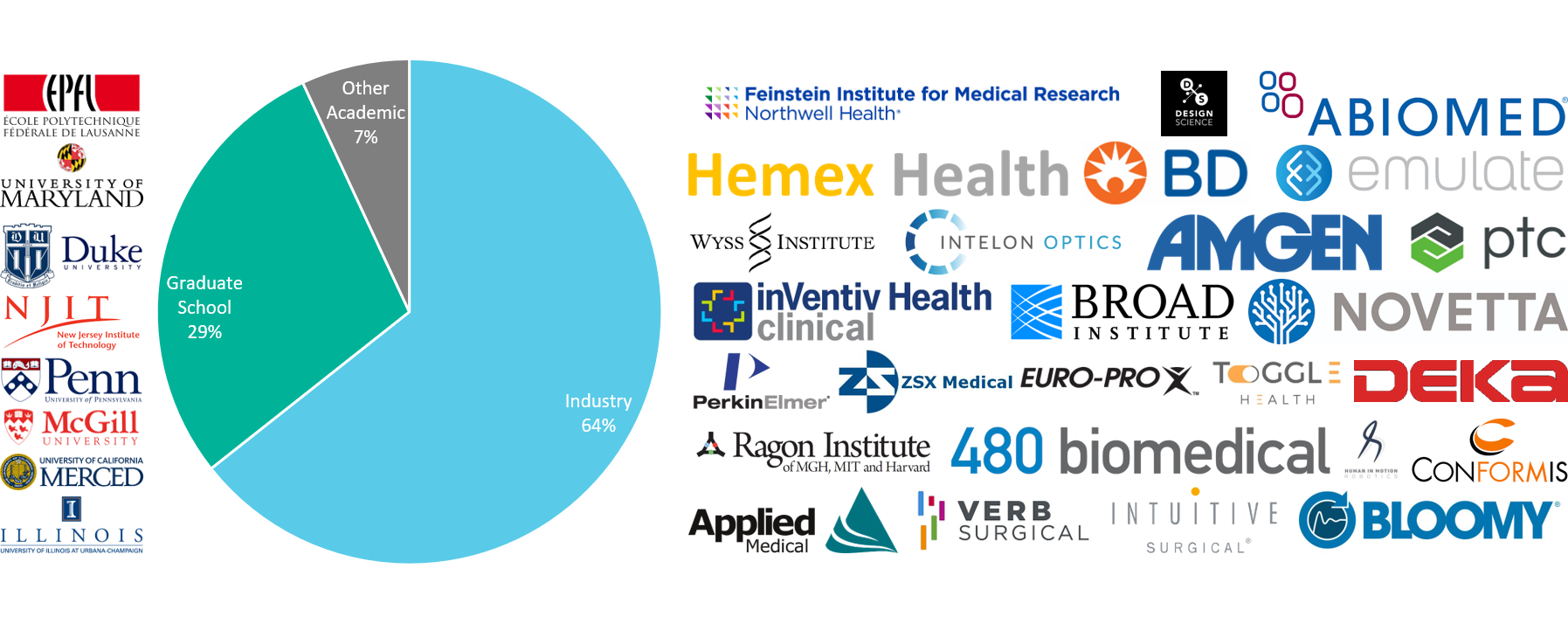Why choose Brown for your master’s?
Our biomedical engineering master's program is ranked #3 by College Choice and ranked #4 by Grad Reports.

Students customize their curriculum.
-
Students can choose to pursue a Master's of Science degree or Master's of Engineering degree:
-
Master of Science Research Track [ScM - Thesis (Research)]
-
Independent, hands-on research experience with world-renowned faculty
-
Students can choose projects from basic science to translational research with biology, engineering, or clinical faculty
-
Written thesis and oral defense required
-
-
Master of Science Design Track [ScM - Thesis (Design)]
-
Team-based design toward an unmet clinical or commercial need in collaboration with faculty, clinical, and/or industry advisors
-
Team written thesis and oral critique required
-
-
Master of Engineering Non-Thesis Track [MEng - Non-thesis]
-
Coursework-based degree
-
Flexibility to explore areas of interest
-
Best suited for those pursuing careers in industry
-
-
-
In all 3 programs:
-
Students customize their course selection based on their research needs and career goals.
-
Students can opt to engage in stimulating co-ops at companies commercializing biomedical technologies.
-
Students can pursue their degree on a part-time or full-time schedule.
-
A wide variety of independent, cutting-edge research projects.
-
Our advisors are passionate, supportive, and committed to strong mentorship.
-
ScM- Thesis (Research) students have advisor flexibility and can choose between hospital based labs or department based labs.
-
Meet our core faculty and affiliated faculty.
-
-
Flexible course work allows for focus on research.
-
Our students publish in top scientific journals e.g.

-
Recent publications by our master's students:
-
Sampath, S.G., Telfeian, A.E., Sullivan, R., Lu, A. and Srivastava, V., 2022. Shape Memory Nitinol Based Minimally Invasive Spinal Cord Stimulation Device Concept for Improved Pain Management. Pain Physician, 25(2), pp.E375-E383.
-
Hoffman-Kim, D., Cruz, R.D.G., El Din, D.M.A. and Okazaki, L., 2022, January. Studying Angular Velocity-Induced Brain Injury in Three-Dimensional Cortical Spheroids. In BRAIN INJURY (Vol. 36, pp. 90-91). 2-4 PARK SQUARE, MILTON PARK, ABINGDON OR14 4RN, OXON, ENGLAND: TAYLOR & FRANCIS LTD.
-
Fariha, R., Jabrah, M., Hill, C., Spooner, A., Deshpande, P. and Tripathi, A., 2022. Simultaneous detection of salivary cortisol and cortisone using an automated high-throughput sample preparation method for LC-MS/MS. SLAS technology.
-
Atherton, E., Brown, S., Papiez, E., Restrepo, M.I. and Borton, D.A., 2021. Lipopolysaccharide-induced neuroinflammation disrupts functional connectivity and community structure in primary cortical microtissues. Scientific reports, 11(1), pp.1-15.
-
Flannery, S.W., Kiapour, A.M., Edgar, D.J., Murray, M.M., Beveridge, J.E. and Fleming, B.C., 2022. A transfer learning approach for automatic segmentation of the surgically treated anterior cruciate ligament. Journal of Orthopaedic Research®, 40(1), pp.277-284.
-
Flannery, S.W., Kiapour, A.M., Edgar, D.J., Murray, M.M. and Fleming, B.C., 2021. Automated magnetic resonance image segmentation of the anterior cruciate ligament. Journal of Orthopaedic Research®, 39(4), pp.831-840.
-
Ip, B.C., Leary, E., Knorlein, B., Reich, D., Van, V., Manning, J. and Morgan, J.R., 2022. 3D Microtissues Mimic the Architecture, Estradiol Synthesis, and Gap Junction Intercellular Communication of the Avascular Granulosa. Toxicological Sciences, 186(1), pp.29-42.
-
Machado, M.C., Vimbela, G.V. and Tripathi, A., 2021. Creation of a low cost, low light bioluminescence sensor for real time biological nitrate sensing in marine environments. Environmental Technology, pp.1-8.
-
Markoski, A., Wong, I.Y. and Borenstein, J.T., 2021. 3D Printed Monolithic Device for the Microfluidic Capture, Perfusion, and Analysis of Multicellular Spheroids. Frontiers in medical technology, 3, p.15.
-
McHugh, B., Akhbari, B., Morton, A.M., Moore, D.C. and Crisco, J.J., 2021. Optical motion capture accuracy is task-dependent in assessing wrist motion. Journal of Biomechanics, 120, p.110362.
-
Sarnik, S.A., Sutermaster, B.A. and Darling, E.M., 2021. Mass‐Added Density Modulation for Sorting Cells Based on Differential Surface Protein Levels. Cytometry Part A, 99(5), pp.488-495.
-
Stinnett, G., Taheri, N., Villanova, J., Bohloul, A., Guo, X., Esposito, E.P., Xiao, Z., Stueber, D., Avendano, C., Decuzzi, P. and Pautler, R.G., 2021. 2D Gadolinium Oxide Nanoplates as T1 Magnetic Resonance Imaging Contrast Agents. Advanced Healthcare Materials, 10(11), p.2001780.
-
Stueber, D.D., Villanova, J., Aponte, I., Xiao, Z. and Colvin, V.L., 2021. Magnetic nanoparticles in biology and medicine: Past, present, and future trends. Pharmaceutics, 13(7), p.943.
-
Welch, E.C., Powell, J.M., Clevinger, T.B., Fairman, A.E. and Shukla, A., 2021. Advances in Biosensors and Diagnostic Technologies Using Nanostructures and Nanomaterials. Advanced Functional Materials, 31(44), p.2104126.
-
Our tuition scale is competitive with other masters's program
- Students pay per course credit and are required to take 8 courses over 4 semesters. Learn more about tuition and fees.
-
Important Notes:
- The Grad School's tuition rates are based on a 4-course per semester schedule, but our program averages a 2-course per semester schedule.
- The BME Master's Program does not follow the pay scale for the Engineering Master's program (it's cheaper!).
Students report high satisfaction with their degree and their experience and continue to great PhD programs and companies.
-
Brown BME alumni and current students can join our LinkedIn Group to network and access job postings.
-
BME ScM Placement (2006-2019, 106 students):
